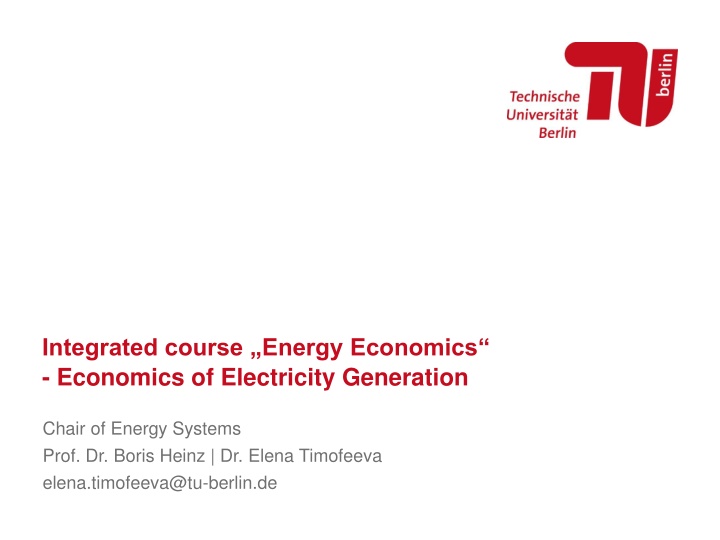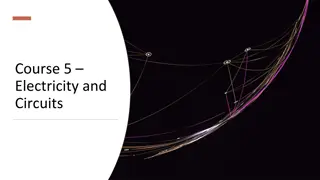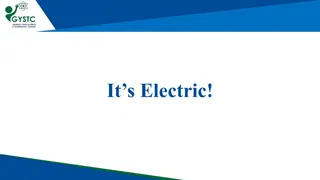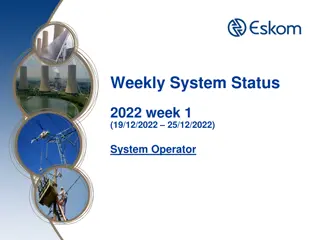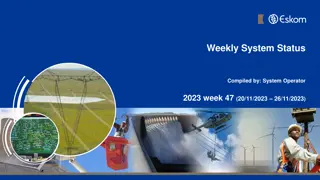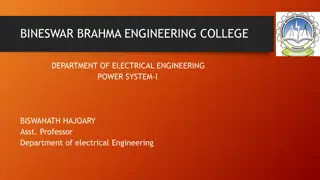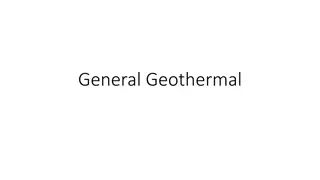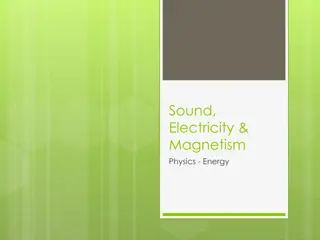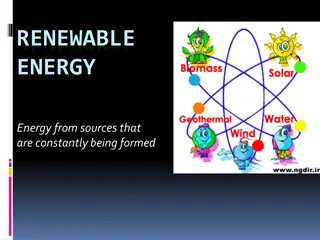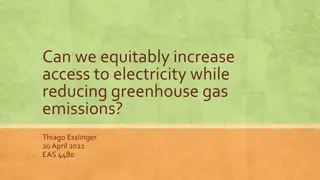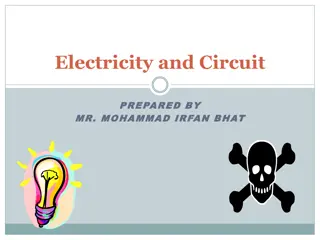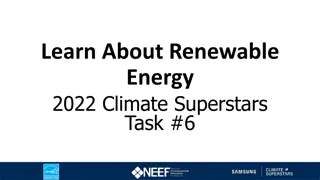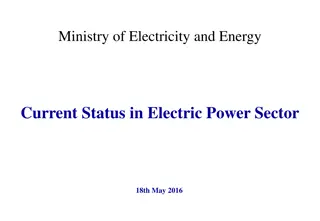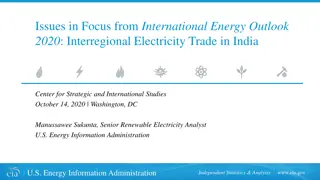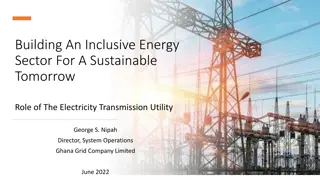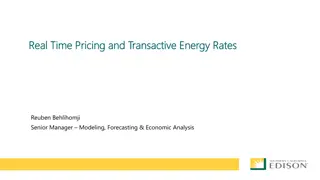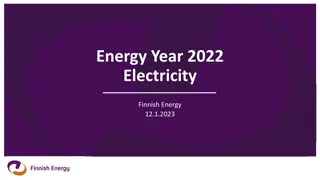Energy Economics - Economics of Electricity Generation
This integrated course explores the cost structures and generation technologies in electricity generation, market power, and renewables support schemes. It delves into merit order, dispatch decisions, full load hours, and factors affecting investment costs, fuel prices, and efficiency in various power plants.
Download Presentation

Please find below an Image/Link to download the presentation.
The content on the website is provided AS IS for your information and personal use only. It may not be sold, licensed, or shared on other websites without obtaining consent from the author.If you encounter any issues during the download, it is possible that the publisher has removed the file from their server.
You are allowed to download the files provided on this website for personal or commercial use, subject to the condition that they are used lawfully. All files are the property of their respective owners.
The content on the website is provided AS IS for your information and personal use only. It may not be sold, licensed, or shared on other websites without obtaining consent from the author.
E N D
Presentation Transcript
Integrated course Energy Economics - Economics of Electricity Generation Chair of Energy Systems Prof. Dr. Boris Heinz | Dr. Elena Timofeeva elena.timofeeva@tu-berlin.de
Outline Cost structures of generation technologies Generation technologies in the merit order Market power in electricity generation Renewables support schemes Seite 2
Task 2) Merit Order and Dispatch Decisions Expected Full Load Hours Capital Recovery Factor Emission Factor Investment Costs Fuel Price Capacity Efficiency Plant [ / [t CO2 / MWhth] [MW] [Million ] [%] [h] [-] MWhth] Nuclear Hard Coal Gas Turbine 900 1 665 36 11 8 000 0.08 - 0.342 750 750 46 20 4 500 0.08 0.198 250 100 36 25 2 000 0.09 Excercise continued from the previous class Slide 3
Expected Full Load Hours Capital Recovery Factor Emission Factor Investment Costs Fuel Price Capacity Efficiency Plant [ / [t CO2 / MWhth] [MW] [Million ] [%] [h] [-] MWhth] Nuclear Hard Coal Gas Turbine 900 1 665 36 11 8 000 0.08 - Task 2) Dispatch Decisions 0.342 750 750 46 20 4 500 0.08 0.198 250 100 36 25 2 000 0.09 b) Assume the power plants given in table 2 have been constructed already. Sketch the merit order for these power plants. What is the electricity price at a load of 1.7 GW? Slide 4
Expected Full Load Hours Capital Recovery Factor Emission Factor Investment Costs Fuel Price Capacity Efficiency Plant [ / [t CO2 / MWhth] [MW] [Million ] [%] [h] [-] MWhth] Nuclear Hard Coal Gas Turbine 900 1 665 36 11 8 000 0.08 - Task 2) Dispatch Decisions 0.342 750 750 46 20 4 500 0.08 0.198 250 100 36 25 2 000 0.09 b) Assume the power plants given in table 2 have been constructed already. Sketch the merit order for these power plants. What is the electricity price at a load of 1.7 GW? 90 100 Price & STMGC [ /Mwhel] 80 70 60 50 40 30 20 10 0 0 500 1000 1500 2000 Cumulative Capacity [MW] Slide 5
Expected Full Load Hours Capital Recovery Factor Emission Factor Investment Costs Fuel Price Capacity Efficiency Plant [ / [t CO2 / MWhth] [MW] [Million ] [%] [h] [-] MWhth] Nuclear Hard Coal Gas Turbine 900 1 665 36 11 8 000 0.08 - Task 2) Dispatch Decisions 0.342 750 750 46 20 4 500 0.08 0.198 250 100 36 25 2 000 0.09 c) Now assume that there is a CO2 trading system. Calculate the emissions price ( /t CO2) at which the coal fired units show the same short-term marginal generation costs as the gas fired ones. Slide 6
Technologies and cost structures: Overview Across technologies, the main cost components are: Capital and investment cost (incl. equipment components, installation, grid connection costs) Operation and maintenance (O&M) Fuel CO2emissions Seite 7
Technologies: Wind Main cost components: Economic depreciation of capital equipment Interest paid on the borrowed capital Operation and maintenance cost Taxes (local / federal) Royalties paid to landowners Payment for electricity used on a standby mode (own consumption) Energy storage components (if used) Source: Ragheb in: Wind Energy Engineering (ed. Letcher), 2017, p.539 Seite 8
Technologies: Wind (continued) Intermittence factor 25% - 40% depending on the location Annual electricity output [kWh/a] = Cap [kW] * 8.760 h/a * IF Exceedance probability (Pxx) of annual energy production: P50: The probability of reaching at least the stated annual energy production is 50. P70, P90 etc. Grid connection has a particular focus in the wind industry. Required grid expansion has to be synchronised with the start of operation. Seite 9
Technologies: Hydropower Extremely high investment cost, mainly in the construction phase Substantial risk associated with construction and operation Low operation and maintenance costs Near zero fuel costs Typically, high grid connection costs for large-scale projects Low cost variability Highly dispatchable Availability of resource is highly seasonal. Source: Bradford, The energy system, 2018, p. 301 Seite 10
Technologies: Nuclear power plants Extremely high investment cost High completion risk No CO2cost Fuel cost Safety, security and waste management considerations Seite 11
Technologies: Coal power plants Capital costs are characterised by economies of scale Low fuel cost Higher CO2 emissions compared to gas Technical limits of operation: low operational flexibility Seite 12
Technologies: Gas-fired power plants Relatively high investment costs Fuel cost has relatively high contribution to LCOE Highly dispatchable Suitable both for peakload and baseload (when relative gas price allows) Important role in system stability Seite 13
Technologies: Summary Source: Zweifel / Praktiknjo / Erdmann, 2017, p. 276 Seite 14
Ramp rates and start-up times of termal power plants Source: Agora Energiewende, 2017, with ref. to: Fichtner (2017), VDE (2012), Steck & Mauch (2008), Balling (2010) Seite 15
Power plants in the merit order Power plant types based on their place in merit order: Power plant type Baseload Intermedium load Peak load FLH [h/a] > 7.000 4.500 5.500 < 1.250 Operation features continuous during peak hours (wd 8-8) at times of peak demand Technologies lignite hard coal pumped- storage hydro, gas old power plants Reserve during power plant shut- downs Source: Konstantin, 2017 Seite 16
Power plants in the merit order Peak load 1250 h/a Intermedium load FLH 4500-5500 h/a Base load FLH 7500 to 8000 h/a Hours Source: Konstantin, 2017 Seite 17
Merit Order: Future trends FLH of conventional power plants will decline with increasing RES share. This along with higher prices of fuel and CO2certificates will lead to higher LCOE. Conventional powerplants with the highest flexibility for ramping up/ramping down have the best chances to stay in the market not necessarily the least expensive ones gas power plants. Source: Fraunhofer ISE, 2018 Seite 18
Market power Perfect competition requires a large number of independent generators. Electricity generation tends to market concentration: few market participants oligopoly. Cournot competition model Incumbent generators have an incentive for: withdrawing generation capacities preventing market entry by newcomers horizontal mergers price control by antitrust authority non-discriminatory access to grid controlled by antitrust/regulatory authority merger control by antitrust authority Seite 19
